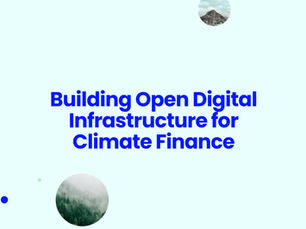
The Rise of Tokenized Carbon Credits: Why Blockchain Is Changing Everything
Summary (TL;DR)
Tokenization is changing the game for the voluntary carbon market (VCM). By using blockchain to represent carbon credits as digital tokens, the industry is achieving greater transparency, reducing double counting, and enabling real-time credit retirement. Here’s why tokenization matters and how platforms like Carbonmark, EcoRegistry, ICR, Puro, Klima Protocol, and Toucan Protocol are driving innovation.
📥 Download the full report here:
Introduction: From Paper-Based Credits to Digital Assets
The voluntary carbon market faces challenges like double counting, fragmented registries, and opaque pricing. Tokenization solves these problems by creating digital representations of verified carbon credits on blockchain, ensuring real-time traceability and interoperability.
The PwC Tokenization Report confirms that tokenization is critical for scaling VCM to billions in annual volume while maintaining trust and market integrity.
How Tokenization Works in Carbon Markets
Credit Verification: Registries issue credits after rigorous validation.
Digital Representation: Credits are tokenized into blockchain-based assets, often on Polygon, Ethereum, or Base.
Onchain Management: Tokens allow instant retirement, fractional ownership, and API-based automation for corporates.

Real-World Examples Driving Tokenization
1. Carbonmark – Marketplace & API for Instant Carbon Access
Carbonmark offers onchain liquidity for carbon credits and enables developers and corporates to automate carbon offsetting through APIs. Businesses can integrate carbon solutions into apps or fintech platforms for seamless climate action.
2. EcoRegistry – Blockchain-Based Registry Infrastructure
EcoRegistry leverages DLT (Distributed Ledger Technology) to register and track carbon credits digitally. By integrating onchain tracking with registry standards, EcoRegistry ensures full traceability from issuance to retirement.
3. ICR (International Carbon Registry)
ICR focuses on digitally native carbon credits, offering an open registry system integrated with blockchain for transparency. This model supports interoperability, enabling credits to move seamlessly into ecosystems and platforms.
4. Puro.Earth – Digital MRV and Tokenization for Removals
Puro specializes in engineered carbon removals (biochar, mineralization) and integrates blockchain verification for immutable credit tracking. Companies like Microsoft and Shopify have used Puro’s digital credits to support permanent carbon storage projects.
5. Klima Protocol & Toucan Protocol – Onchain Carbon Liquidity Pools
Klima Protocol: The liquidity hub for onchain carbon credits, managing a portfolio of approximately 20 million carbon credits. Its platform enhances market accessibility and transparency through carbon credit retirement infrastructure, smart contracts for trading, and publicly available data dashboards.
Toucan Protocol: Enables bridging traditional credits on-chain, supporting programmable climate finance and composability across Web3 ecosystems.
Why Tokenization Matters
✔ Transparency: On-chain records ensure credits are verifiable, reducing fraud and greenwashing.
✔ Liquidity: Tokenization enables 24/7 markets and fractional ownership, democratizing access.
✔ Automation: Smart contracts and APIs simplify reporting, retirement, and integration into digital platforms.
Challenges Ahead
Regulatory Uncertainty under Article 6 compliance frameworks
Interoperability across multiple registries and blockchain networks
Market Education for corporates transitioning to digital-first strategies
The Future of Tokenized Carbon Credits
By 2030, expect AI-driven carbon accounting, cross-chain interoperability, and registry-verified digital credits to become standard. Platforms like Carbonmark, EcoRegistry, and ICR will drive this shift, bridging traditional VCM infrastructure with programmable climate finance.
FAQs
Q1: What is carbon credit tokenization?
It’s converting a verified carbon credit into a blockchain token for secure and transparent trading.
Q2: How does tokenization reduce fraud?
Immutable blockchain records prevent double counting and provide verifiable proof of retirement.
Q3: How can businesses integrate tokenized credits?
Through Carbonmark’s API, enabling automated offsets in apps and digital finance systems.
References & Further Reading
Ready to future-proof your sustainability strategy with tokenized credits?
Explore Carbonmark API.







